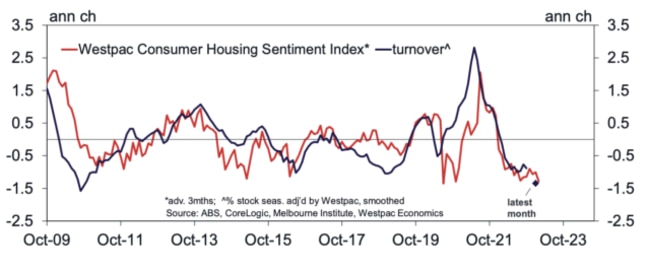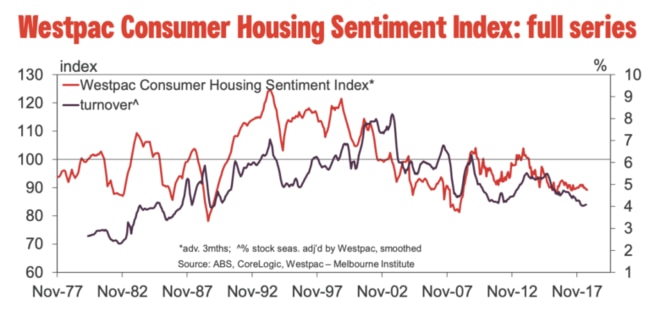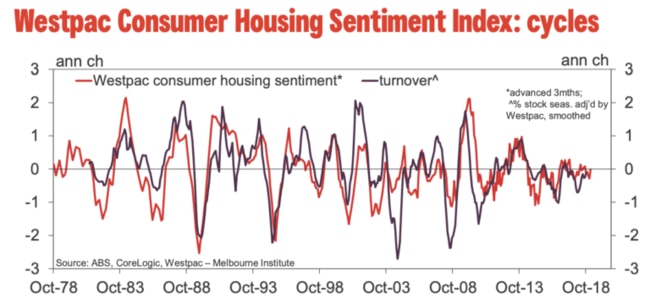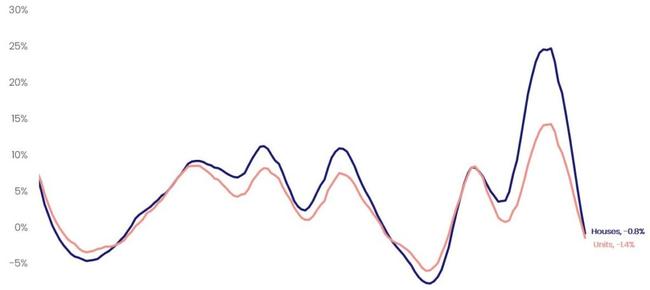No sunny outlook for Australian property prices as ‘correction’ grinds on
Westpac’s latest report on Australia’s housing isn’t cheery reading, but the pain is unevenly spread, with our biggest states hurting the most.

Our historic, RBA flavoured, housing correction is showing absolutely no signs of letting up, according to the latest research out of Westpac.
Aussie home values just continue their merry way back towards earth, while the similar trajectory for both prices and stock turnover has further spread to more sub-markets, the bank warns in its latest property report.

Westpac’s economist Matthew Hassan says it’s not great.
“Heading into late 2022, the picture around current conditions and the near-term outlook remains bleak. Inflation constraints on the RBA, and how its actions impact the economy will be key in 2023–24,” he warns.
For the latest housing news, sign up here for free Stockhead daily newsletters
Eliza Owen, CoreLogic’s head of research, expects price falls to deepen, with 2023 to have some “headwinds and tailwinds for the housing market”.
“I think yes, we’ve got further to go with this downswing,” Owen says. “There was a lot of purchasing done on low fixed rates through the pandemic, with fixed finance comprising around 46 per cent of new lending, and much of that lending will be rolling onto higher mortgage rates in the next 6–12 months.”
There’s no shortage of local economists putting the mocker on further house price falls into next year. AMP’s Shane Oliver has even pegged a 20- 25 per cent fall in national average home prices.
It’s a macro party and I’ll cry if I want to
Rising rates vs a world of inflation are the underlying wider macro-economic fundamentals and in this case at least are likely to continue dominating the near to long-term.
As one pundit put it – Aussie housing is hostage to the global economic cycle and the way the RBA choses to play it.
In an unlikely admission to past follies, the central bank Governor Dr P Lowe apologised on Monday over the ill-advised upbeat guidance around the pandemic, which kinda led to people taking out big mortgages and the mess we’re all admiring now from the inside.
Visit Stockhead, where ASX small caps are big deals
Lowe had publicly and repeatedly said that interest rates wouldn’t be on the rise until 2024.
Since around Christmas, the RBA has hiked its skirts seven times, hoisting the cash rate from 0.1 per cent to 2.85 per cent.
“Looking back, we would have chosen different language. People did not hear the caveats in what we said, and my language was always caveated,” Lowe said today.
“That’s a failure on our part. We didn’t communicate the caveats clearly enough, and we’ve certainly learned from that.”
So now we’re left with watching how fast inflation slows and what happens to the economy when those rate rises hit home.
Now back to the correction
According to Hassan, Aussie housing corrections in the past have “usually followed three distinct phases":
- An initial decline as rate rises impact
- Followed by a further fall as continued high rates combine with economic weakening
- And then a recovery phase via rate cuts and an economic turnaround
According to the bank’s November Housing Pulse, the depression is solidifying.
“The correction (is) becoming more firmly entrenched in most markets and in buyer sentiment,” Hassan said.
Any price-driven improvements in the nation’s awful housing affordability are being easily offset by the pace of rising interest rates and the concomitant “deteriorating expectations” for prices and labour markets.
The report cheerfully notes:
“Our composite Westpac Consumer Housing Sentiment Index points to further declines in turnover heading into 2023 …

” … with more RBA rate rises between now and mid-2023, the correction looks locked in for some time yet.”

Flatter flats
Meanwhile, CoreLogic’s national unit value index declined by 0.8 per cent in October, taking the median value to $598,417, 3.8 per cent below the peak recorded in April.
This saw the annual growth trend for national unit values fall into negative territory for the first time in almost three years, with unit values now -1.4 per cent below the level recorded this time last year.
By comparison, national house values ($779,369) fell 1.3 per cent over the month, taking house values 6.6 per cent below the April peak and 0.8 per cent lower over the 12 months to October.
CoreLogic Economist Kaytlin Ezzy said house values continue to be more sensitive to rising interest rates compared to units.
“As the larger monthly increases in house values recorded over the final quarter of last year fall out of the annual calculation, we’ll likely see the annual growth trends intersect before the performance gap between house and unit values inverts in favour of units,” she said.
As the downward phase of the cycle continues and falling values have become more widespread, the quarterly pace of decline has eased slightly.
Across the combined capitals, the quarterly change in unit values has eased from a 2.7 per cent decline in the September quarter to -2.4 per cent over the three months to October.

“Several factors may have helped influence this deceleration,” Ezzy said. “Not least the smaller increases in the official cash rate between October and November, as well as a lacklustre spring selling season.”
According to the latest CoreLogic work, the average the flow of freshly advertised capital city unit listings has surged by circa 37.1 per cent each year between the end of winter and the spring peak in October.
However, in the wonderful year of our lord, 2022, weaker selling conditions and lower vendor confidence has crimped the flow of fresh unit listings, which fell by -3.6 per cent over the same period.
“This has helped to keep total advertised supply below the previous five-year average, despite a slowdown in buyer demand,” Ezzy added.
Hassan’s State against State
While macro drivers are dominating the collapse in national housing values, the economists at Westpac led by Hassan say the impacts are hitting the states in different ways and to different degrees.
They say corrections are being felt further and deeper in NSW and Victoria, and they look firmly entrenched.
The housing correction is more advanced in NSW, having started earlier in the piece and run at a faster pace, Westpac says.
Sales are down 35 per cent for the year with Sydney prices down 10 per cent.

“Our sentiment–based indicators point to more weakness near term,” Hassan said. “About the only ‘positive’ in the mix looks to be an even sharper pull-back in listings. But while the absence of a large overhang of unsold stock will limit some of the downside on prices, it’s unlikely to stabilise things given momentum and how it is becoming entrenched in expectations.”.
Victoria remains firmly locked in a material housing market correction, Hassan said. And the proof was in a 30 per cent fall in turnover from its 2021 high (albeit with declines exaggerated by last year’s Delta disruptions).

“Melbourne dwelling prices are down just 7 per cent from their 2022 peak, monthly declines running at a steady pace despite a moderation since mid-year,” Hassan said.
“Sentiment points to more of the same in early 2023. Affordability and the supply–demand balance remain less supportive than in most other markets although the latter is shifting, the physical demand for housing set to get a big boost as migration inflows return.”
Westpac says Queensland, Tasmania, the ACT and most regions of major eastern states are now experiencing material price declines as well.
Queensland’s housing market has been the big mover this year, switching abruptly from a vigorous boom that was still in full-swing back in Q1 to steep declines in turnover and prices in the second half.

Turnover in the great state of Queensland is off 10 per cent, albeit still around long-run average levels.
“Prices have been much weaker, gapping 5.4 per cent lower in Jul-Oct, having just stalled flat over the previous three months. Sentiment has turned sharply weaker as well,” Hassan notes.
Western Australia and South Australia continue to hold up much better, but are seeing momentum stall and sentiment turn down sharply.

SA’s boom started later and is running longer than other eastern states.
“Remarkably,” Matthew adds, “barring an extreme weakening in the final months, both turnover and prices are set to finish higher for calendar 2022.”

Tasmania’s housing market correction has deepened over the last three months, turnover continuing to move lower and price declines accelerating and broadening, Westpac says.
“Performance-wise, the state sits somewhere between the very weak NSW and Victoria markets and the milder downturn in Queensland.”

“For a long time now the state’s housing market has wrestled with acute supply shortages, an associated long run of strong price gains leading to very stretched affordability, comparable to that seen in NSW and Vic,” Hassan said.
“Accordingly, rate hikes have triggered a sharp drop back in demand that is playing through quickly to prices.
“However,” he warns, “supply is still very tight, suggesting that prices could ‘yoyo’ again if and when interest rates start to move lower.”
This content first appeared on stockhead.com.au
SUBSCRIBE
Get the latest Stockhead news delivered free to your inbox. Click here


